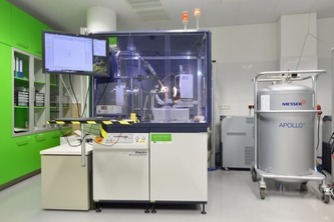View All X-Ray Techniques at Instruct
X-ray Diffraction and Bio-SAXS laboratories are a part of Biomolecular Interactions and Crystallography core facility (BIC) at CEITEC Instruct centre. The laboratories are equipped with top-class instruments for diffraction experiments with single crystal samples focused on the determination of the 3-D structure of (macro)molecules down to atomic resolution and for small angle X-ray scattering experiments with isotropically scattering samples focused on determination of the shape and size of macromolecules or nanoparticles.
Services include diffraction/SAXS data collection, analysis and structure determination.
More information can be found on the Biomolecular Interactions and Crystallography core facility webpage.
Rigaku BioSAXS-2000 SAXS camera for small angle X-ray scattering from solutions of biological macromolecules. The instrument is equipped with a robotic sample changer for 96 well plates.
Rigaku OD XtaLAB Synergy Custom, robotised macromolecular diffraction system with ACTOR sample changer optimised for work at Cu-Kα wavelength. Rigaku OD XtaLAB Synergy-DW, universal, dual wavelength (Mo-Kα and Cu-Kα) diffractometer.
The range of applicable molecular mass for diffraction methods: from 102 up to 106, where the lower value covers molecules significant for nanotechnology, materials science or pharmacology and the upper limit covers bio-macromolecules such as nucleic acids, proteins and their complexes.
Range of applicable particle sizes for SAXS: from 2 to 100 nm.
For both, diffraction and SAXS, samples could be delivered in person or via delivery service as a mail-in access.
The diffraction of X-rays in single crystal samples is the most important and – if an appropriate sample is available – also the fastest methodology currently available for the determination of the atomic structures of molecules and/or macromolecules and their complexes.
On the other hand, SAXS is a technique capable of determining structural characteristics such as mono dispersity or aggregation, oligomeric state, low resolution three-dimensional shape or even quaternary structure not from a crystal but from a solution of (bio) macromolecules.
The centralised organisation of expensive instrumentation for SAXS and single crystal studies and highly trained staff allow the cost-effective use of resources and obtaining of experimental results in rapid responses to the demands of even untrained users.

